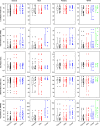Automated delineation of hospital service areas as a new tool for health care planning
- PMID: 32078171
- PMCID: PMC7240760
- DOI: 10.1111/1475-6773.13275
Automated delineation of hospital service areas as a new tool for health care planning
Abstract
Objective: To develop an automated, reproducible method for delineating hospital service areas (HSAs).
Data sources/setting: Discharge data from all Swiss acute care hospitals for the years 2013 to 2016.
Study design: We derived HSAs and hospital referral regions for Switzerland using a newly developed flow-based, automated, objective, and reproducible method using all discharge data. We compared our method to the classical, partially subjective approach used to delineate the Swiss Health Care Atlas by delineating four sets of intervention-specific HSAs.
Principal findings: Based on 4 105 885 discharges, the fully automated method delineated 63 HSAs. Comparison with existing HSAs reveals good overlap and comparable measures of health utilization between the methods and shows that in the Swiss setting, our method outperforms a cluster-based approach to defining HSAs. While the classical method potentially takes an entire day to delineate the regions, our method took approximately 10 minutes.
Conclusions: Hospital service areas are used to analyze differences in use of health care that may indicate underuse and overuse. Our new, fully automated, objective, and reproducible method provides a useful tool for hospital services researchers that will enable them to delineate and update patient-flow-based HSAs.
Keywords: Mapcurve; Switzerland; hospital referral regions.
© Health Research and Educational Trust.
Figures


References
-
- Kilaru AS, Wiebe DJ, Karp DN, Love J, Kallan MJ, Carr BG. Do hospital service areas and hospital referral regions define discrete health care populations? Med Care. 2015;53(6):510‐516. - PubMed
-
- Widmer M, Matter P, Staub L, Schoeni‐Affolter F, Busato A. Regional variation in orthopedic surgery in Switzerland. Health Place. 2009;15(3):761‐768. - PubMed
-
- Wennberg J, Gittelsohn A. Small area variations in health care delivery: a population‐based health information system can guide planning and regulatory decision‐making. Science. 1973;182(4117):1102‐1108. - PubMed
-
- Center for the Evaluative Clinical Sciences . The Dartmouth Atlas of Health Care 1998. Chicago, IL: AHA; 1998. - PubMed
Publication types
MeSH terms
LinkOut - more resources
Full Text Sources

